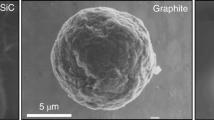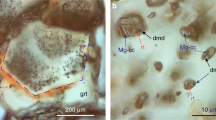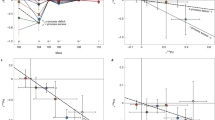Abstract
Recently Lewis et al.1 have identified the C δstructure, previously found in C1, C2 and.C3 carbonaceous chrondrites, as diamond powder (that is, grains typically 50 Å in diameter). The Cδ is enriched (compared to the atmosphere of the Sun) in heavy and light isotopes of Xe (Xe-HL) and therefore assumed to be of pre-solar origin. In laboratory experiments Roy2 has described how small layers of diamonds can form at low pressure and at temperatures normally attributed to the grain-forming layers of cool stellar atmospheres (∼1,000–2,000 K). Lewis et al.1 therefore suggest following the original idea of Clayton3, that the diamonds found in meteorites are formed in the upper atmosphere of red giant stars. Here it is shown that the diamonds must have formed in the type of red giants called carbon stars, and that Xe-HL and diamonds cannot have formed in the same star, but must be produced one in each component of a close binary system. The diamonds are produced in the smaller of the components, near the end of its evolution, the Xe-HL is produced when the compact remnant (a white dwarf) of the bigger component has accreted so much mass from the carbon star that it explodes as a supernova. This is consistent with the normal evolution of type I supernovae (SNI), and it is demonstrated that there were appreciably more carbon stars participating in SNI formation at the time of Solar System formation than today. Finally, the thermodynamic conditions are found under which the diamonds are produced, and it is explained why Xe-HL is found in diamonds but not in silicon carbide, and why s-process Xe is expected to be found in silicon carbide (Cβ).
This is a preview of subscription content, access via your institution
Access options
Subscribe to this journal
Receive 51 print issues and online access
$199.00 per year
only $3.90 per issue
Buy this article
- Purchase on Springer Link
- Instant access to full article PDF
Prices may be subject to local taxes which are calculated during checkout
Similar content being viewed by others
References
Lewis, R. S., Ming, T., Wacker, J. F., Anders, E. & Steel, E. Nature 326, 160–162 (1987).
Roy, R. Nature 325, 17–18 (1987).
Clayton, D. D. Astrophys. J. 199, 765–769 (1975).
Schmid-Burgk, J. & Scholz, M. in Physical Processes in Red Giants (eds Iben, I, Jr. & Renzini, A.) 341–346 (Reidel, Dordrecht, 1981).
Draine, B. T. in Physical Processes in Red Giants (eds Iben, I, Jr. & Renzini, A.) 317–333 (Reidel, Dordrecht, 1981).
Salpeter, E. E. Rev. Mod. Phys. 46, 433–436 (1974).
Eriksson, K., Gustafsson, B., Jørgensen, U. G. & Nordlund, Å. Astr. Astrophys. 132, 37–44 (1984).
Jørgensen, U. G., Almlöf, J. & Siegbahn, P. E. M. J. Chem. Phys. (submitted).
Jørgensen, U. G. Thesis, Copenhagen Univ., 1987.
Renzini, A. & Voli M. Astr. Astrophys. 94, 175–193 (1981).
Bertelli, G., Bressan, A. G. & Chiosi, C. Astr. Astrophys. 150, 33–52 (1985).
Woosley, S. E. in Nucleosynthesis and Chemical Evolution (eds Hauck, B., Maeder, A. & Meynet, G.) 1–195 (Geneva Observatory, 1986).
Clayton, D. D. Proc. Lunar Planet. Sci. 12B, 1781–1802 (Pergamon Press, Oxford, 1981).
Lambert, D. L. in Cool Stars with Excesses of Heavy Elements (eds Jaschek, M. & Keenan, P. C.) 191–223 (Reidel, Dordrecht, 1985).
Lewis, R. S. & Anders, E. Astrophys. J. 247, 1122–1124 (1981).
Miller, G. E. & Scalo, J. M. Astrophys. J. 263, 259–268 (1982).
Strömgren, B. in The Galaxy (eds Gilmore, G. & Carswell, R.) (Reidel, Dordrecht, in the press).
Olsen, E. H. Ast. Astrophys. Suppl. 57, 443–466 (1984).
Peimbert, M. & Torres-Peimbert, S. Astrophys. J. 193, 327–333 (1974).
Richer, H. B. & Westerlund, B. E. Astrophys. J. 264, 114–125 (1983).
Cook, K. H., Aaronson, M. & Norris, J. Astrophys. J. 305, 634–644 (1986).
Reimers, D. Mem. Soc. Roy. Sci. Liege. Ser. 6 8, 369–382 (1975).
Iben, I. Jr & Renzini, A. Ah. Rev. Astr. Astrophys. 21, 271–342 (1983).
Lambert, D. L., Gustafsson, B., Eriksson, K. & Hinkle, K. H. Astrophys. J. Suppl. 62, 373–425 (1986).
Lewis, R. S. & Anders, E. Scient. Am. 249, 54–66 (1983).
Bernatowicz, T. et al. Nature 330, 728–730 (1987).
Zinner, E., Ming, T. & Anders, E. Nature 330, 730–732 (1987).
Author information
Authors and Affiliations
Rights and permissions
About this article
Cite this article
Jørgensen, U. Formation of Xe-HL-enriched diamond grains in stellar environments. Nature 332, 702–705 (1988). https://doi.org/10.1038/332702a0
Received:
Accepted:
Issue Date:
DOI: https://doi.org/10.1038/332702a0
This article is cited by
-
Interstellar Carbonaceous Dust and Its Formation Pathways: From an Experimental Astrochemistry Perspective
Journal of the Indian Institute of Science (2023)
-
Dust metamorphosis in the galaxy
The Astronomy and Astrophysics Review (1995)
-
Interstellar grains in meteorites
Nature (1993)
-
Supernovae as sources of interstellar diamonds
Astrophysics and Space Science (1992)
-
Thep-nuclei: abundances and origins
The Astronomy and Astrophysics Review (1992)
Comments
By submitting a comment you agree to abide by our Terms and Community Guidelines. If you find something abusive or that does not comply with our terms or guidelines please flag it as inappropriate.



